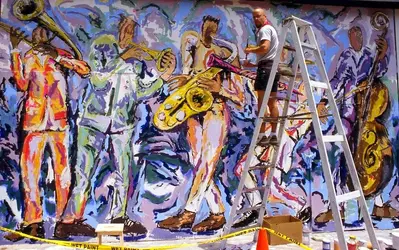TJMcG
TPF Noob!
- Joined
- Feb 16, 2022
- Messages
- 48
- Reaction score
- 38
- Location
- Show Low, Arizona, USA
- Can others edit my Photos
- Photos OK to edit
Technical stuff:
Camera: Nikon Z7II
Lens: Nikkor VR 70-300 f/4.5-5.6 @70 mm
Aperture priority
f/8 @ 1/60 sec
ISO 64
-Post processing
Colour, exposure etc.
any adjustments made in software.
This began as a raw image. I opened in Adobe Camera Raw and did basic developing, (exposure, shadows/highlights, vibrance/saturation, etc.) then opened it in Photoshop CC where I first duplicated the layer, used Overlay blend mode to give it a little more contrast and saturation, reduced opacity until it looked right, then used a solid color adjustment layer in Linear Light blend mode (an orangish/red color) at about 7% fill for a slightly warmer tone. There were some other minor tweaks using Hue/Sat, Color Balance and so on. I used a seven-tone luminosity mask action that I created to slightly reduce highlights.
-Why did I take the shot?
I have lived in Arizona for more than 15 years. I live in an area of pine forests, but Sonoran desert scenes and Giant Saguaro are iconic here, (in fact it is the only place in the world where this cactus is native) and I want one of those iconic scenes in my own collection. This is Picacho Peak State Park.
- What was the goal?
Stated above.
-What image did you have in mind when you took the image?
A vibrant, living desert. Amazing cactus.
-Was there a specific learning goal?
No.
- Did I achieve my goal?
Not if a great, vibrant, alive image of the Sonoran Desert was the goal.
-Do you see anything that looks off, takes your attention away from the subject, etc.
The subject that I was trying to portray is the area; the cactus marching up the mountainside, the sagebrush, the sand; you know: the desert. Not a single cactus, but a point of view. What "looks off" to me is that there just isn't the vibrance, the liveliness that I have seen in other depictions. (Not that I want to be a copycat, I want my own point of view, just with more excitement in it.)
- If I could, what would I change?
Everyone should be able to answer this one. There's always that one or two things that you could have done different/better.
This assumes facts not in evidence. I know photography, I know Photoshop and editing, I don't know what to do with this to get it to "pop." Simply increasing saturation or contrast isn't going to give me what I'm looking for. I was not able to go there at a time of "golden light," so I had to make do with early afternoon. Maybe one thing I would change is the time of day, but that was not an option.
-What critique am I looking for?
I want to know how to photograph the desert, and why my desert photos never look like my vision.

Camera: Nikon Z7II
Lens: Nikkor VR 70-300 f/4.5-5.6 @70 mm
Aperture priority
f/8 @ 1/60 sec
ISO 64
-Post processing
Colour, exposure etc.
any adjustments made in software.
This began as a raw image. I opened in Adobe Camera Raw and did basic developing, (exposure, shadows/highlights, vibrance/saturation, etc.) then opened it in Photoshop CC where I first duplicated the layer, used Overlay blend mode to give it a little more contrast and saturation, reduced opacity until it looked right, then used a solid color adjustment layer in Linear Light blend mode (an orangish/red color) at about 7% fill for a slightly warmer tone. There were some other minor tweaks using Hue/Sat, Color Balance and so on. I used a seven-tone luminosity mask action that I created to slightly reduce highlights.
-Why did I take the shot?
I have lived in Arizona for more than 15 years. I live in an area of pine forests, but Sonoran desert scenes and Giant Saguaro are iconic here, (in fact it is the only place in the world where this cactus is native) and I want one of those iconic scenes in my own collection. This is Picacho Peak State Park.
- What was the goal?
Stated above.
-What image did you have in mind when you took the image?
A vibrant, living desert. Amazing cactus.
-Was there a specific learning goal?
No.
- Did I achieve my goal?
Not if a great, vibrant, alive image of the Sonoran Desert was the goal.
-Do you see anything that looks off, takes your attention away from the subject, etc.
The subject that I was trying to portray is the area; the cactus marching up the mountainside, the sagebrush, the sand; you know: the desert. Not a single cactus, but a point of view. What "looks off" to me is that there just isn't the vibrance, the liveliness that I have seen in other depictions. (Not that I want to be a copycat, I want my own point of view, just with more excitement in it.)
- If I could, what would I change?
Everyone should be able to answer this one. There's always that one or two things that you could have done different/better.
This assumes facts not in evidence. I know photography, I know Photoshop and editing, I don't know what to do with this to get it to "pop." Simply increasing saturation or contrast isn't going to give me what I'm looking for. I was not able to go there at a time of "golden light," so I had to make do with early afternoon. Maybe one thing I would change is the time of day, but that was not an option.
-What critique am I looking for?
I want to know how to photograph the desert, and why my desert photos never look like my vision.




![[No title]](/data/xfmg/thumbnail/42/42481-e35ff0c514a554d7bd4381fb2ae79c5a.jpg?1734177006)







![[No title]](/data/xfmg/thumbnail/42/42480-70a0d1b3ccdeb380098dd12f512b4a17.jpg?1734177006)
